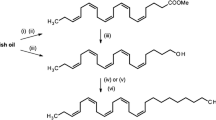Abstract
The specific status ofCtenopseustis obliquana pheromone-types I, II, and III has been more fully examined. Females of types I and III produce a mixture of (Z)-8- and (Z)-5-tetradecenyl acetates (Z8-14:Ac, Z5-14: Ac). The previously reported different ratios of these two components in females of the two types (type I=80∶20, III=90∶10) have been reinvestigated. The median ratios of each type differed significantly, although there was some overlap in the ranges of these ratios. A field cage trial showed that males of type III are attracted to females of type I, so the observed differences may be ascribed to intraspecific variation. In contrast to females of types I or III, females of type II produce Z5-14∶Ac but no Z8-14∶Ac. The electroantennogram (EAG) profile of antennae of type II males shows a maximum response to Z5-14∶Ac, while the EAG profiles of types I and III show a strong response to Z8-14∶Ac. In wind tunnel tests using mixtures of these two compounds, type II males prefer blends consisting of all or mostly Z5-14: Ac, while type I males showed a preference to a mix of 70% Z8-14∶Ac plus 30% Z5-14∶Ac. We found that type I males are attracted to type I females when offered a choice between type I and type II females in a field cage test and that type II males similarly prefer type II females. Males of types I and II have specialist cells for Z8-14∶Ac and Z5-14∶Ac but differ with respect to relative densities of these cells and to further cell types responsive to other alkenyl acetates. Type IIC. obliquana is considered therefore a sibling species of types I and III. In addition, the amount of Z5-14∶Ac produced by type II females varied geographically. Females from the North Island produced significantly less (median=1.2 ng) Z5-14∶Ac than females from the South Island (median=2.2 ng). Type II populations in the North Island morphologically resembled sympatric type I, rather than type II from the South Island and are designated as type II (North Island). Type II (North Island) populations have so far been found only at Rukuhia (near Hamilton) and from Kerikeri. In contrast, type II populations are sympatric with type III populations over much of the South Island. In a field cage trial, males of types II and II (North Island) were attracted to females of both II and II (North Island). We tentatively ascribe the differences between type II and type II (North Island) to intraspecific variation.
Similar content being viewed by others
References
Baker, T.C., andRoelofs, W.L. 1976. Electroantennogram responses of the male mothArgyrotaenia velutinana to mixtures of sex pheromone components of the female.J. Insect Physiol. 22:1357–1364.
Clearwater, J.R., andTriggs, C.M. 1991. Pheromone blend discrimination by sexually active maleCtenopseustis obliquana is dependent on bioassay conditions. In preparation.
Crosby, T.K., Dugdale, J.S., andWatt, J.C. 1976. Recording specimen localities in New Zealand.N.Z. J. Zool. 3:69.
Dugdale, J.S. 1990. Reassessment ofCtenopseustis Meyrick andPlanotortrix Dugdale with descriptions of two new genera (Lepidoptera: Tortricidae).N.Z. J. Zool. 18:3.
Foster, S.P., andRoelofs, W.L. 1987. Sex pheromone differences in populations of the brownheaded leafroller Ctenopseustis obliquana.J. Chem. Ecol. 13:623–629.
Foster, S.P., Clearwater, J.R., Muggleston, S.J., Dugdale, J.S., andRoelofs, W.L. 1986. Probable sibling species complexes within two described New Zealand leafroller moths.Naturwissenschaften 7 3: S. 15 6.
Galbreath, R.A., Benn, M.H., Young, H., andHolt, V.A. 1985. Sex pheromone components in New Zealand greenheaded leafrollerPlanotortrix excessana (Lepidoptera: Tortricidae).Z.Naturforsch. 40c:266–271.
Green, C.J., andDugdale, J.S. 1982. Review of the genusCtenopseustis Meyrick (Lepidoptera: Tortricidae), with reinstatement of two species.N.Z. J. Zool. 9:427–436.
Priesner, E. 1983. Receptors for di-unsaturated pheromone analogues in the male summerfruit tortrix moth.Z. Naturforsch. 38c:874–877.
Taschenberg, E.F.,Cardé, R.T.,Hill, A.,Tette, J.P., andRoelofs, W.L. Sex pheromone trapping of the grapeberry moth.Environ. Entomol. 3:192–194.
Van der Pers, J.N.C., andLöfstedt, C. 1986. Chap. 27 Signal-response relationships in sex pheromone communication in mechanisms, pp. 235–241, in Insect Olfaction. T.L. Payne, M.C. Birch, and C.E.J. Kennedy (eds.). Clarendon Press, Oxford.
Wearing, C.H.,Thomas, W.P.,Dugdale, J.S., andDanthanarayana, W. 1990. Australian and New Zealand species,in Tortricoid Pests, Their Biology, Natural Enemies and Control. Elsevier, Amsterdam. In press.
Young, H., Galbreath, R.A., Benn, M.H., Holt, V.A., andStruble, D.L. 1985. Sex pheromone components in the New Zealand brownheaded leafrollerCtenopseustis obliquana (Lepidoptera: Tortricidae).Z. Naturforsch 40c: 262–265.
Author information
Authors and Affiliations
Rights and permissions
About this article
Cite this article
Clearwater, J.R., Foster, S.P., Muggleston, S.J. et al. Intraspecific variation and interspecific differences in sex pheromones of sibling species inCtenopseustis obliquana complex. J Chem Ecol 17, 413–429 (1991). https://doi.org/10.1007/BF00994342
Received:
Accepted:
Issue Date:
DOI: https://doi.org/10.1007/BF00994342




